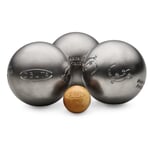Boule leisure ball

Boule leisure ball
- Ball set for beginners* and recreational players*
- Suitable for small to medium hand sizes
- Made of stainless steel, boxwood target ball
General Information
From laying and shooting
The most popular ball game in this country - and commonly subsumed under "Boule" - is undoubtedly the pétanque imported from France, a variant of the Jeu Provençal launched in 1910 near Marseille, which is played at shorter distances. Even the novice player will quickly understand what the game is all about: on the one hand, to place one's own ball close to the target ball ("laying") and, on the other hand, to worsen the position of the opponent's balls by hitting them away ("shooting").
Johann Christoph Friedrich GutsMuths, German pedagogue of the Goethe period and co-founder of gymnastics, already summed up in apt words how challenging and at the same time pleasurable the game with the balls is: "The throwing of the balls requires an exact weighing of the strength of the arm, proper estimation of the weight against the distance of the throw. If the playground always remained the same, its peculiarities would soon be known; but it changes with each new course, always appearing other depressions, elevations and canopies. The eye must spy these out, and they become an object of the judgment. To this is added, finally, the constant measuring of the distances of the balls. All this makes the game artful, useful and interesting, just as it becomes immensely entertaining by chance, which chases the balls sometimes this way, sometimes that way. It therefore deserves a fairly general reception among young and adult alike."
Experience Meets Curiosity. A game for young and old
Similar to archery, in the game of boules not only the physical fitness of the players is decisive for success. Rather, the combination of concentration, technique and experience is decisive for the outcome. So it is not surprising that petanque inspires many into old age, whether "Tête-à-tête" (singles), "Doublette" (doubles) or "Triplette" (triples). Often it is precisely these experienced players who introduce the game to the next generations and tell them practical tricks.
To ensure that the young curious also have lasting pleasure in laying and shooting, we also offer balls for juniors in addition to the competition and leisure balls for adults. The following applies to all "boules de pétanque": They should be adapted to the shape of the hand and the length of the fingers. To test, shape the palm of your hand into a hollow - all fingers should form a unit, with the thumb slightly angled against the index finger. Place the ball in the hollow and turn the back of the hand upward. If it remains well secured in your hand and does not fall down, the ball will fit; it is important that you can keep your fingers closed without cramping your hand. When throwing, all fingers should then release from the ball at the same time.
From the home of pétanque. Balls from La Boule Obut
While the southern French farmers used wooden balls studded with nails all around in the past, purely steel specimens are used in pétanque today. Our balls come from the French family-owned company La Boule Obut , which has made a name for itself in leisure and competition circles since it was founded in 1955 and is the market leader.
La Boule Obut manufactures the "boules de pétanque" entirely at its headquarters near Saint-Étienne (Loire) using proven production techniques. Shells are forged there from steel discs, which when assembled make balls - the inside remains empty in accordance with the NF S 52-200 standard. The guideline states, among other things, that balls must not be filled with foreign bodies for safety reasons, as these could corrode due to moisture and cause the shell to burst. In order to achieve the necessary competition weight, quality manufacturers therefore rely on balls with a solid jacket. In addition to the weight, the hardness and material properties are also decisive for how a ball hits the ground and rolls. For example, our competition balls made of carbon steel with a black oxide coating bounce less because of their surface hardness and bounce less off hit balls than specimens made of other materials.
Product Information
Article Number 34723
- Ball set for beginners* and recreational players*
- Suitable for small to medium hand sizes
- Made of stainless steel, boxwood target ball
3 large boules balls (Ø 7.3 cm) made of stainless steel. Weight per ball 620 g. With a small ball made of boxwood, Ø 3 cm. Supplied in a cloth bag.
Have a question?
If you have a question concerning this product you are welcome to contact us. For this your E-Mail program will open.
Contact Us
For advice, spare parts or special requests - our customer service will take care of your questions and concerns, personally and competently.
You can reach us from Monday to Friday at +49 2309 939095 or anytime at info@manufactum.com
Gift Certificates
It is good for everything: With our PDF gift certificates you can choose from the entire Manufactum selection. Pick a motif which you can send by email or print out and present personally, immediately after submitting your order.
Order now


